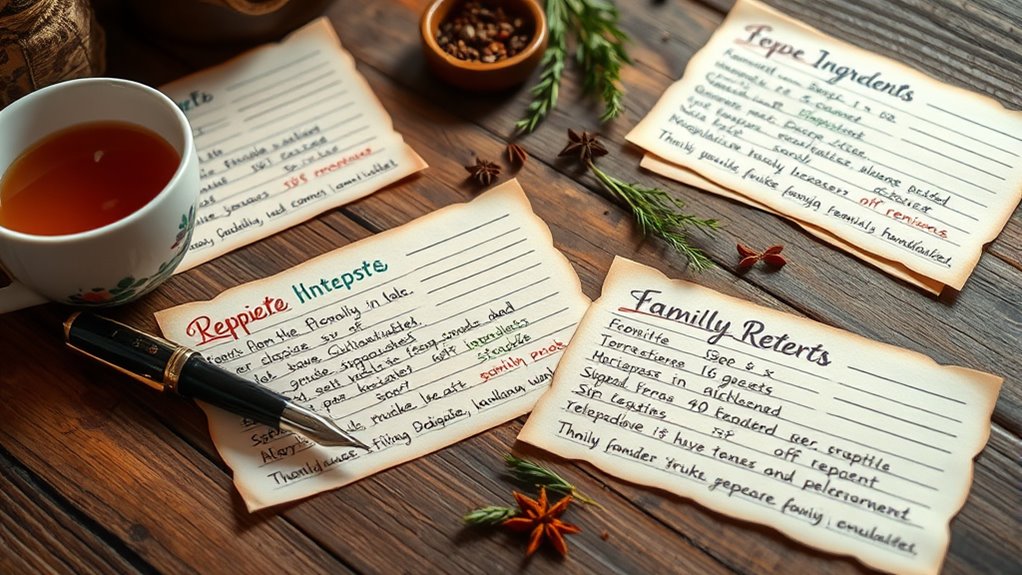Creating personalized family recipe cards allows you to preserve your culinary heritage with a personal touch. You can select layouts that reflect your family style, use handwriting or design software for decoration, and add stories or tips to make each card unique. Organize your recipes by categories and update them as you discover new favorites. If you want to learn more about crafting beautiful, meaningful recipe cards that celebrate your family’s traditions, keep exploring these tips.
Key Takeaways
- Select a family-inspired layout and design that reflects your style, incorporating colors, fonts, and images for a personalized look.
- Handwrite recipes for a warm, authentic touch or use design software to add decorative elements and customize details.
- Organize recipes by categories like meal type or occasion, and include notes, tips, or substitutions to enhance usability.
- Add visual elements such as borders, icons, or photos to make the cards more engaging and visually appealing.
- Involve family members in sharing stories and variations to preserve the culinary heritage and create meaningful keepsakes.

Creating personalized family recipe cards is a wonderful way to preserve and share your favorite dishes with loved ones. When you start designing these cards, it’s helpful to consider the rich history of recipes and how they’ve evolved over time. Recipes have been passed down through generations, often changing with each family’s unique tastes and traditions. Understanding this history allows you to appreciate the significance of your family’s culinary heritage and inspires you to keep it alive in a personalized format. As you craft your recipe cards, think about incorporating stories or memories associated with each dish. This personal touch not only honors your family’s history but also makes the recipe more meaningful for anyone who receives it.
Creating family recipe cards preserves cherished traditions and stories for generations to come.
When it comes to customization tips, focus on how you can make each recipe card distinctly yours. Start with selecting a layout that reflects your family’s style—whether it’s vintage, modern, or whimsical. Use colors, fonts, and images that resonate with your family’s personality. Handwriting the recipes adds a warm, personal touch that digital printing often can’t replicate. If you prefer a more polished look, consider using design software or online templates to add decorative borders, icons, or photos. Including additional details such as cooking tips, ingredient substitutions, or even a note about why the dish is special can turn a simple recipe into a treasured keepsake. Incorporating visual elements can also enhance the appeal and make the cards more engaging.
As you gather your recipes, think about how you want to organize them. You might categorize by meal type, occasion, or ingredient. Grouping similar recipes together makes it easier for loved ones to find what they need and encourages them to try new dishes. Don’t forget to update your cards over time—adding new favorites or variations keeps your collection fresh and relevant. You can also involve family members in the process, allowing everyone to contribute their own stories or tweaks, making the collection even more personal and all-encompassing.
Ultimately, creating personalized family recipe cards isn’t just about documenting ingredients and instructions; it’s about capturing the stories, traditions, and love that go into each dish. By understanding the history of recipes and applying thoughtful customization tips, you ensure that your culinary heritage is preserved beautifully. These cards become more than just instructions—they become a tangible connection to your family’s past, a gift for future generations, and a heartfelt way to celebrate your shared love of good food.
Frequently Asked Questions
What Materials Are Best for Durable Recipe Cards?
You should choose water-resistant paper or laminated cardstock for durable recipe cards. Water-resistant paper resists spills and moisture, keeping your recipes intact. Laminated cardstock provides an extra layer of protection, making the cards sturdy and long-lasting. Both options are ideal for everyday kitchen use, ensuring your recipes stay in great condition despite splashes or humidity. Invest in these materials to create family recipe cards that stand the test of time.
How Can I Incorporate Family History Into the Design?
Why settle for plain when you can flaunt your family’s secrets? Incorporate family history motifs like vintage design elements—think old-fashioned aprons, heirloom tools, or handwritten notes—into your recipe cards. Use subtle background images or borders that echo your family’s story, turning each card into a nostalgic treasure. It’s a delightful way to honor your roots while keeping those cherished recipes beautifully preserved and instantly recognizable.
What Digital Tools Are Recommended for Creating Personalized Cards?
You should explore digital tools like Canva or Adobe Spark for creating personalized family recipe cards. These platforms offer customizable digital templates that make design easy and fun. You can also take advantage of font customization options to match your family’s style or add historical touches. With these tools, you’re empowered to craft unique, memorable cards quickly, ensuring each recipe reflects your family’s culinary heritage beautifully.
How Do I Preserve Handwritten Recipes on Cards?
To preserve handwritten recipes on cards, start by using archival-quality materials like acid-free paper and waterproof ink to prevent recipe aging and guarantee handwriting preservation. Store your cards in a cool, dry place away from sunlight to maintain their condition. Consider scanning or digitizing the recipes for backup, and handle the cards gently to avoid smudging or tearing, keeping your family’s culinary legacy intact for generations.
Are There Eco-Friendly Options for Making Recipe Cards?
Yes, you can choose eco-friendly options like recyclable paper and plant-based inks for your recipe cards. While it might seem like a small step, using biodegradable materials guarantees your family traditions leave a lighter footprint on the environment. Just as recipes are passed down through generations, sustainable choices now help preserve our planet’s future. Embrace these greener options to keep your family’s culinary legacy thriving responsibly.
Conclusion
Creating personalized family recipe cards is like planting seeds of tradition that bloom with each shared meal. These cards become symbols of love, memories, and heritage, passing from one generation to the next. As you craft each card, you’re weaving together stories and flavors that stand the test of time. In doing so, you’re not just preserving recipes—you’re nurturing a legacy that continues to grow, nourishing hearts and souls with every handwritten note.









